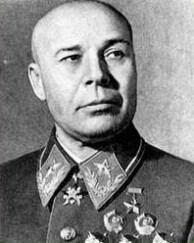Role Military Commander Name Semyon Timoshenko | Awards Nationality Soviet Union | |
 | ||
Premier Vyacheslav MolotovJoseph Stalin Full Name Semyon Konstantinovich Timoshenko Political party Communist Party of the Soviet Union Party Communist Party of the Soviet Union Children Olga Timoshenko, Ekaterina Timoshenko Similar People | ||
1st of May 1941 | Internationale [RARE]
Semyon Konstantinovich Timoshenko (Russian: Семён Константи́нович Тимоше́нко, Semën Konstantinovič Timošenko; Ukrainian: Семе́н Костянти́нович Тимоше́нко, Semen Kostiantynovych Tymoshenko) (18 February [O.S. 6 February] 1895 – 31 March 1970) was a Soviet military commander and Marshal of the Soviet Union.
Contents
- 1st of May 1941 Internationale RARE
- Early life
- First World War
- The Russian Civil War and the 1930s
- The Winter War
- World War II
- Postwar
- Awards
- References

Early life
Timoshenko was born into a peasant family of Ukrainian ethnicity at Furmanivka, in the Budjak region (Southern Bessarabia, present-day Odessa Oblast, Ukraine).
First World War
In 1914, he was drafted into the army of the Russian Empire and served as a cavalryman on Russia's western front. On the outbreak of the Russian Revolution in 1917, he sided with the Bolsheviks, joining the Red Army in 1918 and the Bolshevik Party in 1919.
The Russian Civil War and the 1930s
During the Russian Civil War, Timoshenko fought on various fronts. His most important encounter occurred at Tsaritsyn (later renamed Stalingrad), where he commanded a cavalry regiment, and met and befriended Joseph Stalin, who was responsible for the city's defense. This connection would ensure his rapid advancement after Stalin gained control of the Communist Party by the end of the 1920s. In 1920–1921, Timoshenko served under Semyon Budyonny in the 1st Cavalry Army; he and Budyonny would become the core of the "Cavalry Army clique" which, under Stalin's patronage, would dominate the Red Army for many years.
Timoshenko fought against Polish forces in Kiev and then against Pyotr Wrangel's White Army and Nestor Makhno's Black Army. By the end of the Civil and Polish–Soviet Wars, Timoshenko had become the commander of the Red Army cavalry forces. Thereafter, under Stalin, he became Red Army commander in Byelorussia (1933); in Kiev (1935); in the northern Caucasus and then Kharkov (1937); and Kiev again (1938). In 1939, he was given command of the entire western border region and led the Ukrainian Front during the Soviet occupation of eastern Poland. He also became a member of the Communist Party's Central Committee. Due to being a loyal friend of Stalin, Timoshenko survived the Great Purge to become the Red Army's senior professional soldier.
The Winter War
In January 1940, Timoshenko took charge of the Soviet armies fighting Finland in the Soviet-Finnish War. This had begun the previous November, under the disastrous command of Kliment Voroshilov. Under Timoshenko's leadership, the Soviets succeeded in breaking through the Finnish Mannerheim Line on the Karelian Isthmus, prompting Finland to sue for peace in March. His reputation increased, Timoshenko was made the People's Commissar for Defence and a Marshal of the Soviet Union in May, replacing Stalin's crony Marshal Voroshilov as Commissar.
British historian John Erickson has written:
Although by no means a military intellectual, Timoshenko had at least passed through the higher command courses of the Red Army and was a fully trained 'commander-commissar'. During the critical period of the military purge, Stalin had used Timoshenko as a military district commander who could hold key appointments while their incumbents were liquidated or exiled.
Timoshenko was a competent but traditionalist military commander who nonetheless saw the urgent need to modernise the Red Army if, as expected, it was to fight a war against Nazi Germany. Overcoming the opposition of other more conservative leaders, he undertook the mechanisation of the Red Army and the production of more tanks. He also reintroduced much of the traditional harsh discipline of the Tsarist Russian Army.
World War II
Following the German invasion of the Soviet Union, Timoshenko was named chairman of Stavka, the Soviet Armed Forces High Command, on June 23, 1941.. In July 1941, Stalin replaced Timoshenko as Defense Commissar and Stavka's chairman before sending him to the Central Front and Western Front to supervise a fighting retreat from the border to Smolensk. In September, he was transferred to the Ukraine to replace Budyonny and restore order in the Southwestern Front at the gates of Kiev. In November and December 1941 Timoshenko organized major counter offensives in the Rostov region, as well as carving a bridgehead into German defenses south of Kharkov in January 1942.
In May 1942, Timoshenko, with 640,000 men, launched a counter-offensive (the Second Battle of Kharkov) which was the first Soviet attempt to gain initiative in the springtime war. After initial Soviet successes, the Germans struck back at Timoshenko's exposed southern flank, halting the offensive, encircling Timoshenko's armies, and turning the battle into a major Soviet defeat.
General Georgy Zhukov's success in defending Moscow during December 1941 had persuaded Stalin that he was a better commander than Timoshenko. Stalin removed Timoshenko from front-line command, giving him roles as overall commander of the Stalingrad (June 1942), then North-Western (October 1942), Leningrad (June 1943), Caucasus (June 1944) and Baltic (August 1944) fronts.
Between 15 August 1945 and 15 September 1945, Marshal Timoshenko traveled alone to review the Starye Dorogi displaced persons camp where Auschwitz concentration camp survivors recuperated after their liberation. Later author Primo Levi (Prisoner 174517) wrote in The Truce, how the extremely tall Timoshenko "unfolded himself from a tiny Fiat 500A Topolino" to announce the liberated survivors would soon begin their final journey home.
Postwar
After the war, Timoshenko was reappointed commander of the Baranovichi Military District (Byelorussian Military District since March 1946), then of the South Urals Military District (June 1946); and then the Byelorussian Military District once again (March 1949). In 1960, he was appointed Inspector-General of the Defence Ministry, a largely honorary post. From 1961 he chaired the State Committee for War Veterans. He died in Moscow in 1970.
